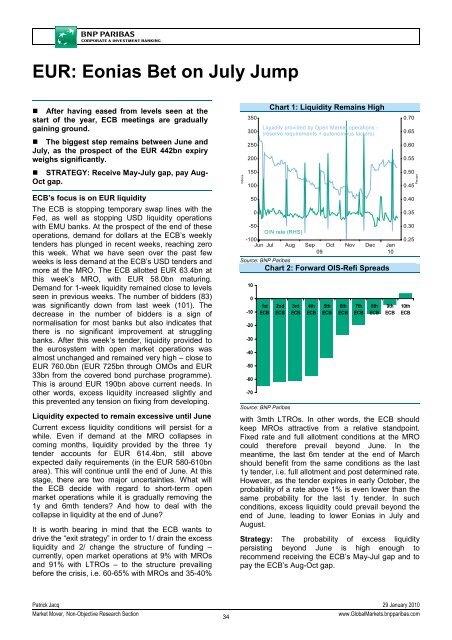Market Outlook - BNP PARIBAS - Investment Services India
Market Outlook - BNP PARIBAS - Investment Services India
Market Outlook - BNP PARIBAS - Investment Services India
You also want an ePaper? Increase the reach of your titles
YUMPU automatically turns print PDFs into web optimized ePapers that Google loves.
EUR: Eonias Bet on July Jump<br />
• After having eased from levels seen at the<br />
start of the year, ECB meetings are gradually<br />
gaining ground.<br />
• The biggest step remains between June and<br />
July, as the prospect of the EUR 442bn expiry<br />
weighs significantly.<br />
• STRATEGY: Receive May-July gap, pay Aug-<br />
Oct gap.<br />
ECB’s focus is on EUR liquidity<br />
The ECB is stopping temporary swap lines with the<br />
Fed, as well as stopping USD liquidity operations<br />
with EMU banks. At the prospect of the end of these<br />
operations, demand for dollars at the ECB’s weekly<br />
tenders has plunged in recent weeks, reaching zero<br />
this week. What we have seen over the past few<br />
weeks is less demand at the ECB’s USD tenders and<br />
more at the MRO. The ECB allotted EUR 63.4bn at<br />
this week’s MRO, with EUR 58.0bn maturing.<br />
Demand for 1-week liquidity remained close to levels<br />
seen in previous weeks. The number of bidders (83)<br />
was significantly down from last week (101). The<br />
decrease in the number of bidders is a sign of<br />
normalisation for most banks but also indicates that<br />
there is no significant improvement at struggling<br />
banks. After this week’s tender, liquidity provided to<br />
the eurosystem with open market operations was<br />
almost unchanged and remained very high – close to<br />
EUR 760.0bn (EUR 725bn through OMOs and EUR<br />
33bn from the covered bond purchase programme).<br />
This is around EUR 190bn above current needs. In<br />
other words, excess liquidity increased slightly and<br />
this prevented any tension on fixing from developing.<br />
Liquidity expected to remain excessive until June<br />
Current excess liquidity conditions will persist for a<br />
while. Even if demand at the MRO collapses in<br />
coming months, liquidity provided by the three 1y<br />
tender accounts for EUR 614.4bn, still above<br />
expected daily requirements (in the EUR 580-610bn<br />
area). This will continue until the end of June. At this<br />
stage, there are two major uncertainties. What will<br />
the ECB decide with regard to short-term open<br />
market operations while it is gradually removing the<br />
1y and 6mth tenders? And how to deal with the<br />
collapse in liquidity at the end of June?<br />
It is worth bearing in mind that the ECB wants to<br />
drive the “exit strategy” in order to 1/ drain the excess<br />
liquidity and 2/ change the structure of funding –<br />
currently, open market operations at 9% with MROs<br />
and 91% with LTROs – to the structure prevailing<br />
before the crisis, i.e. 60-65% with MROs and 35-40%<br />
billions<br />
350<br />
300<br />
250<br />
200<br />
150<br />
100<br />
50<br />
0<br />
Chart 1: Liquidity Remains High<br />
Liquidity provided by Open <strong>Market</strong> operations -<br />
(reserve requirements + autonomous factors)<br />
-50<br />
O/N rate (RHS)<br />
-100<br />
Jun Jul Aug Sep Oct Nov Dec Jan<br />
09<br />
10<br />
Source: <strong>BNP</strong> Paribas<br />
Chart 2: Forward OIS-Refi Spreads<br />
10<br />
0<br />
-10<br />
-20<br />
-30<br />
-40<br />
-50<br />
-60<br />
-70<br />
1st<br />
ECB<br />
2nd<br />
ECB<br />
Source: <strong>BNP</strong> Paribas<br />
3rd<br />
ECB<br />
4th<br />
ECB<br />
5th<br />
ECB<br />
6th<br />
ECB<br />
7th<br />
ECB<br />
8th<br />
ECB<br />
9th<br />
ECB<br />
0.70<br />
0.65<br />
0.60<br />
0.55<br />
0.50<br />
0.45<br />
0.40<br />
0.35<br />
0.30<br />
0.25<br />
10th<br />
ECB<br />
with 3mth LTROs. In other words, the ECB should<br />
keep MROs attractive from a relative standpoint.<br />
Fixed rate and full allotment conditions at the MRO<br />
could therefore prevail beyond June. In the<br />
meantime, the last 6m tender at the end of March<br />
should benefit from the same conditions as the last<br />
1y tender, i.e. full allotment and post determined rate.<br />
However, as the tender expires in early October, the<br />
probability of a rate above 1% is even lower than the<br />
same probability for the last 1y tender. In such<br />
conditions, excess liquidity could prevail beyond the<br />
end of June, leading to lower Eonias in July and<br />
August.<br />
Strategy: The probability of excess liquidity<br />
persisting beyond June is high enough to<br />
recommend receiving the ECB’s May-Jul gap and to<br />
pay the ECB’s Aug-Oct gap.<br />
Percent<br />
Patrick Jacq 29 January 2010<br />
<strong>Market</strong> Mover, Non-Objective Research Section<br />
34<br />
www.Global<strong>Market</strong>s.bnpparibas.com
















